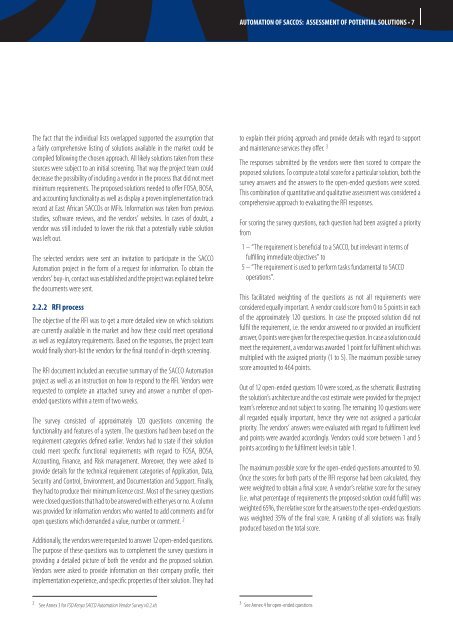Automation of SACCOs - FSD Kenya
Automation of SACCOs - FSD Kenya
Automation of SACCOs - FSD Kenya
Create successful ePaper yourself
Turn your PDF publications into a flip-book with our unique Google optimized e-Paper software.
The fact that the individual lists overlapped supported the assumption that<br />
a fairly comprehensive listing <strong>of</strong> solutions available in the market could be<br />
compiled following the chosen approach. All likely solutions taken from these<br />
sources were subject to an initial screening. That way the project team could<br />
decrease the possibility <strong>of</strong> including a vendor in the process that did not meet<br />
minimum requirements. The proposed solutions needed to <strong>of</strong>fer FOSA, BOSA,<br />
and accounting functionality as well as display a proven implementation track<br />
record at East African <strong>SACCOs</strong> or MFIs. Information was taken from previous<br />
studies, s<strong>of</strong>tware reviews, and the vendors’ websites. In cases <strong>of</strong> doubt, a<br />
vendor was still included to lower the risk that a potentially viable solution<br />
was left out.<br />
The selected vendors were sent an invitation to participate in the SACCO<br />
<strong>Automation</strong> project in the form <strong>of</strong> a request for information. To obtain the<br />
vendors’ buy-in, contact was established and the project was explained before<br />
the documents were sent.<br />
2.2.2 rFI process<br />
The objective <strong>of</strong> the RFI was to get a more detailed view on which solutions<br />
are currently available in the market and how these could meet operational<br />
as well as regulatory requirements. Based on the responses, the project team<br />
would finally short-list the vendors for the final round <strong>of</strong> in-depth screening.<br />
The RFI document included an executive summary <strong>of</strong> the SACCO <strong>Automation</strong><br />
project as well as an instruction on how to respond to the RFI. Vendors were<br />
requested to complete an attached survey and answer a number <strong>of</strong> openended<br />
questions within a term <strong>of</strong> two weeks.<br />
The survey consisted <strong>of</strong> approximately 120 questions concerning the<br />
functionality and features <strong>of</strong> a system. The questions had been based on the<br />
requirement categories defined earlier. Vendors had to state if their solution<br />
could meet specific functional requirements with regard to FOSA, BOSA,<br />
Accounting, Finance, and Risk management. Moreover, they were asked to<br />
provide details for the technical requirement categories <strong>of</strong> Application, Data,<br />
Security and Control, Environment, and Documentation and Support. Finally,<br />
they had to produce their minimum licence cost. Most <strong>of</strong> the survey questions<br />
were closed questions that had to be answered with either yes or no. A column<br />
was provided for information vendors who wanted to add comments and for<br />
open questions which demanded a value, number or comment. 2<br />
Additionally, the vendors were requested to answer 12 open-ended questions.<br />
The purpose <strong>of</strong> these questions was to complement the survey questions in<br />
providing a detailed picture <strong>of</strong> both the vendor and the proposed solution.<br />
Vendors were asked to provide information on their company pr<strong>of</strong>ile, their<br />
implementation experience, and specific properties <strong>of</strong> their solution. They had<br />
2 See Annex 3 for <strong>FSD</strong> <strong>Kenya</strong> SACCO <strong>Automation</strong> Vendor Survey v0.2.xls<br />
AUTOMATION OF SACCOS: ASSESSMENT OF POTENTIAL SOLUTIONS • 7<br />
to explain their pricing approach and provide details with regard to support<br />
and maintenance services they <strong>of</strong>fer. 3<br />
The responses submitted by the vendors were then scored to compare the<br />
proposed solutions. To compute a total score for a particular solution, both the<br />
survey answers and the answers to the open-ended questions were scored.<br />
This combination <strong>of</strong> quantitative and qualitative assessment was considered a<br />
comprehensive approach to evaluating the RFI responses.<br />
For scoring the survey questions, each question had been assigned a priority<br />
from<br />
1 – “The requirement is beneficial to a SACCO, but irrelevant in terms <strong>of</strong><br />
fulfilling immediate objectives” to<br />
5 – “The requirement is used to perform tasks fundamental to SACCO<br />
operations”.<br />
This facilitated weighting <strong>of</strong> the questions as not all requirements were<br />
considered equally important. A vendor could score from 0 to 5 points in each<br />
<strong>of</strong> the approximately 120 questions. In case the proposed solution did not<br />
fulfil the requirement, i.e. the vendor answered no or provided an insufficient<br />
answer, 0 points were given for the respective question. In case a solution could<br />
meet the requirement, a vendor was awarded 1 point for fulfilment which was<br />
multiplied with the assigned priority (1 to 5). The maximum possible survey<br />
score amounted to 464 points.<br />
Out <strong>of</strong> 12 open-ended questions 10 were scored, as the schematic illustrating<br />
the solution’s architecture and the cost estimate were provided for the project<br />
team’s reference and not subject to scoring. The remaining 10 questions were<br />
all regarded equally important, hence they were not assigned a particular<br />
priority. The vendors’ answers were evaluated with regard to fulfilment level<br />
and points were awarded accordingly. Vendors could score between 1 and 5<br />
points according to the fulfilment levels in table 1.<br />
The maximum possible score for the open-ended questions amounted to 50.<br />
Once the scores for both parts <strong>of</strong> the RFI response had been calculated, they<br />
were weighted to obtain a final score. A vendor’s relative score for the survey<br />
(i.e. what percentage <strong>of</strong> requirements the proposed solution could fulfil) was<br />
weighted 65%, the relative score for the answers to the open-ended questions<br />
was weighted 35% <strong>of</strong> the final score. A ranking <strong>of</strong> all solutions was finally<br />
produced based on the total score.<br />
3 See Annex 4 for open-ended questions
















